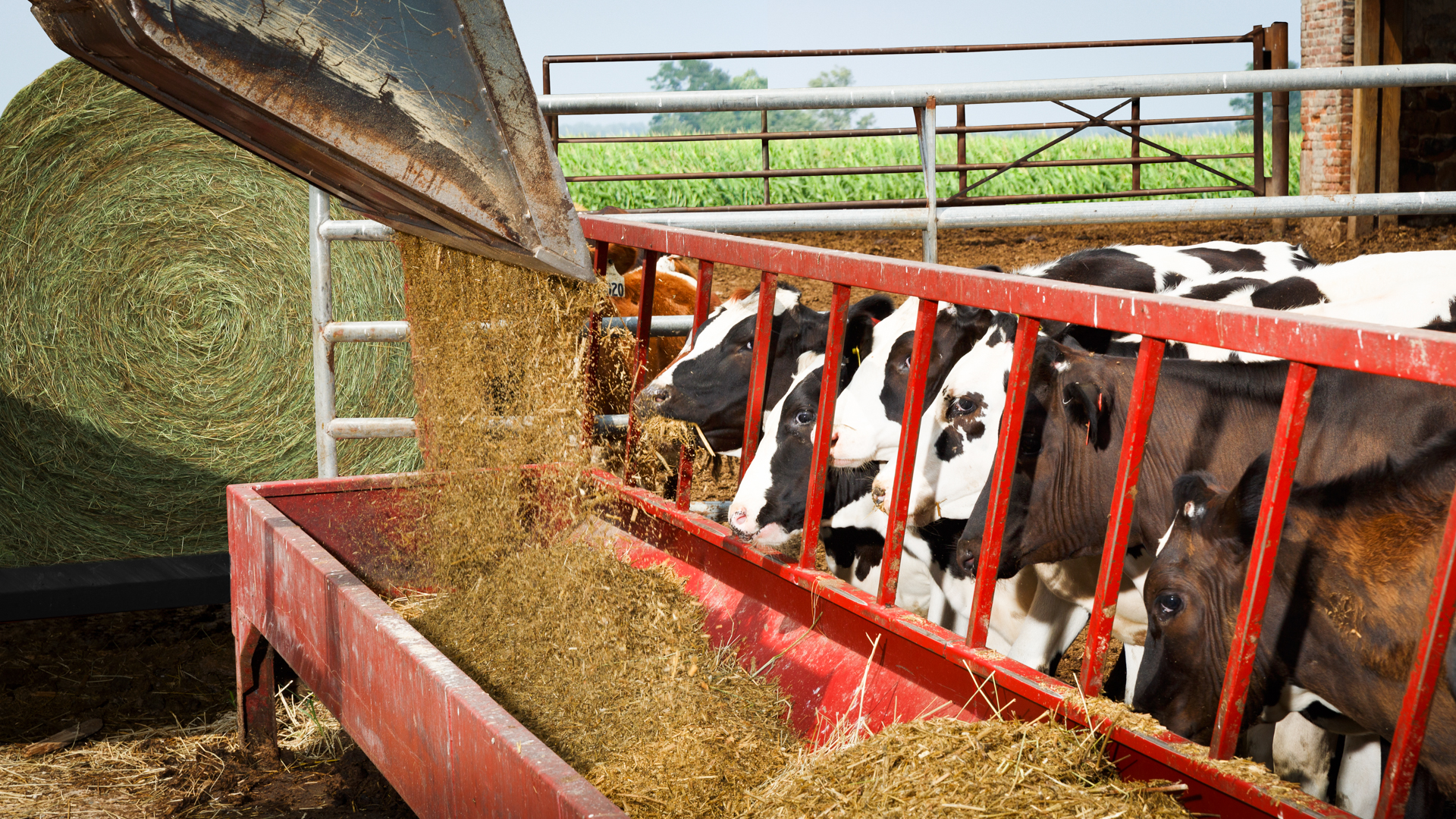
Fact 1: Cattle eat a lot of hay. Fact 2: A lot of hay is wasted every time you feed your cattle. Although “no waste hay feeders for cattle” are never 100% waste free, you can save a lot of hay with a feeder compared to ground-feeding your cows.
How Much Hay Do Cows Waste?
Before we dive into how to keep cows from wasting hay with a hay feeder, let’s look into how much hay a cow actually wastes.
A cow needs to eat about 25-30 lbs. of (92%-100% dry matter) hay in a day (around 2% of body weight).
Based on those estimates, here’s a simple breakdown of how much hay a cow or herds of cattle eat.
Table 1
| # of Cows | Hay Consumed in 30 Days | Hay Consumed in 90 Days | Hay Consumed in 365 Days |
| 1 head | 750-900 lbs. | 2,300-2,700 lbs. | 9,200-11,000 lbs. |
| 10 head | 7,500-9,000 lbs. | 22,500-27,000 lbs. | 92,300-109,500 lbs. |
| 50 head | 37,500-45,000 lbs. | 112,500-135,000 lbs. | 456,300-547,500 lbs. |
Note: We are assuming hay is 92%-100% dry matter.
Simply put, a cow can waste almost half of the hay that it’s given (45%) if given unlimited access to ground-fed hay. But this all depends on the method of feeding.
Here’s a further breakdown of 4 feeding methods:
Table 2
| Feeding Method | Hay Waste (percentage of original bale) |
| Ground-Fed (unlimited access) | 45% |
| Hay Net | <10% |
| Cone Feeder | 5%-21% |
| Minimum Waste Hay Feeder for Cattle (see bunk feeder or bale feeder) | 4%-15% |
Note: These are estimates and may not always be accurate across the board.
Referencing Table 2, we’ll calculate the amount of hay that is wasted by each feeding method.
Table 3
| Feeding Method | Hay Waste per/Ton | Hay Waste per/5 Tons | Hay Waste per/25 Tons |
| Ground-Fed (unlimited access) | 900 lbs. | 4,500 lbs. | 22,500 lbs. |
| Hay Net | <200 lbs. | <1000 lbs. | <5,000 lbs. |
| Cone Feeder | 100-420 lbs. | 500-2,100 lbs. | 2,500-10,500 lbs. |
| Minimum Waste Hay Feeder for Cattle (see bunk feeder or bale feeder) | 80-300 lbs. | 400-1,500 lbs. | 2,000-7,500 lbs. |
Note: These are estimates and may not always be accurate across the board.
Converting that into dollars, a ton of hay costs anywhere from $30-$300 per ton. Based on how much hay is wasted in Table 2, we’ll estimate how much money you’re losing because of hay waste.
Table 4
| Feeding Method | $$$ Lost Per/Ton | $$$ Lost Per/5 Tons | $$$ Lost Per/25 Tons |
| Ground-Fed (unlimited access) | $14-$140 | $70-$700 | $350-$3,400 |
| Hay Net | <$3-$30 | <$15-$150 | <$75-$750 |
| Cone Feeder | $1.50-$63 | $7.50-$315 | $38-$1,600 |
| Minimum Waste Hay Feeder for Cattle (see bunk feeder or bale feeder) | $1.20-$45 | $6-$225 | $30-$1,130 |
Note: These are estimates and may not always be accurate across the board.
You can quickly see that a minimum-waste hay feeder for cattle is an investment that will probably save you thousands of dollars in the future. Why not request a free quote on one now?
How Do You Keep Cows from Wasting Hay?
We might’ve stolen our own thunder already, but there are many ways to keep cows from wasting hay. We’ll divide these methods into 3 different categories.
1. How To Keep Cows from Wasting Hay: Daily Feeding Methods
Feeding your cattle daily, rather than periodically, can greatly help keep your cows from wasting hay. We’ll break the daily feeding methods down into 2 sub-methods.
Loose Round Bale
Feeding a large round bale on the ground is not a preferred method of feeding. However, if the bale is unrolled and loosened, a waste percentage of about 12% can be expected…if fed daily. However, that’s still a lot of hay just sitting around. Plus, if you distribute more than a day’s amount of hay on the ground for your cattle, the waste percentage skyrockets to 40%.
Pros
- No need to invest in a feeder/hay net
- Simple feeding process
Cons
- Need to feed cows every day
- A lot of hay still gets trampled and wasted
Loose Small Square and Small Round Bales
Hay distributed in small square or round bales should be spread evenly throughout the field. Again, this must be done in daily portions in order to keep hay waste at an absolute minimum.
Pros
- No investment in hay feeders
- Keeps hay waste less than some methods
Cons
- Expensive
- Takes time to feed every day
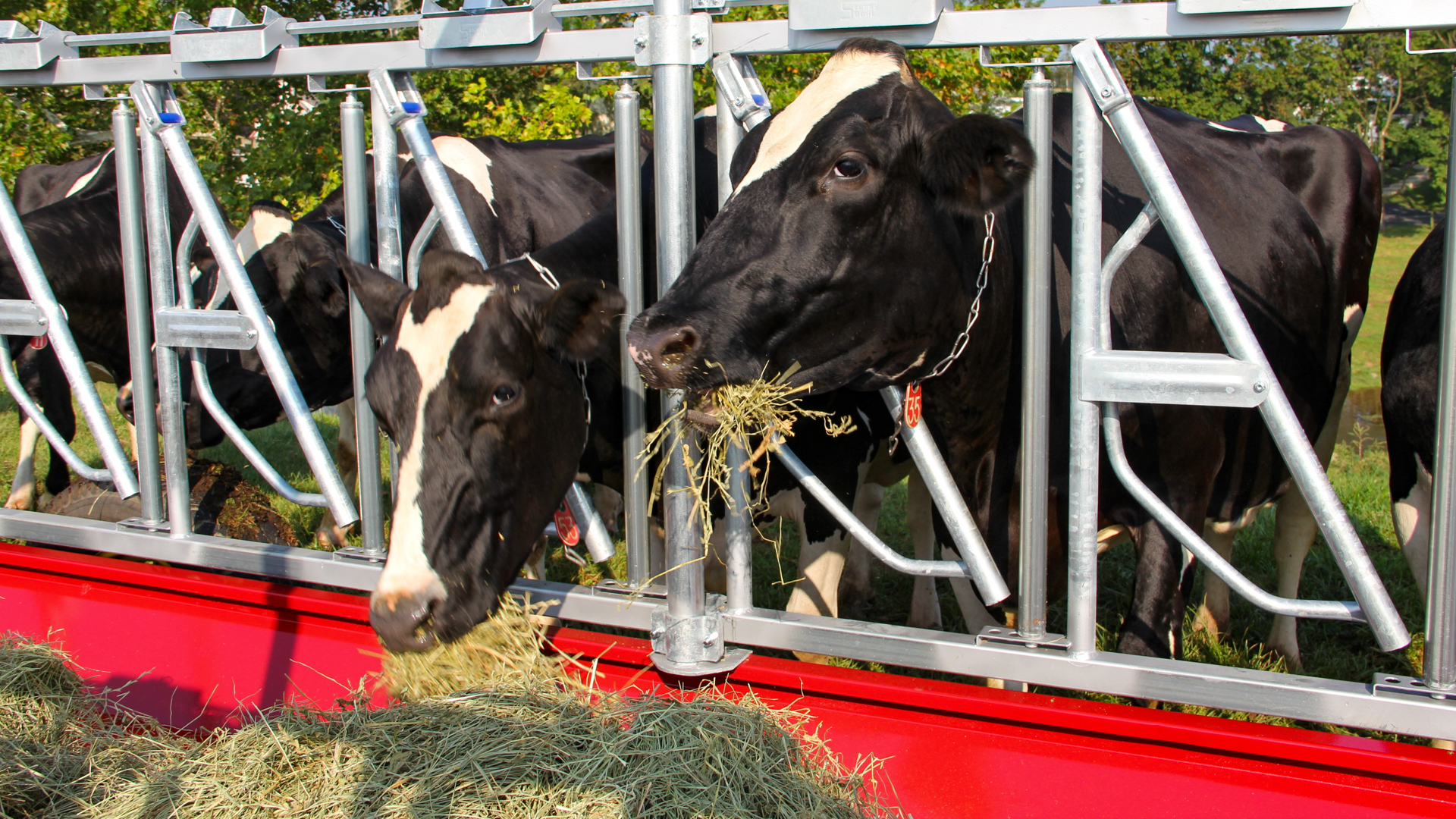
2. How To Keep Cows From Wasting Hay: Periodic Feeding
There are a couple of cattle feeding methods where you can keep both hay waste and time at a minimum: hay nets or hay feeders.
Haynet
A hay net is a great option for reducing hay waste with minimum investment. All you have to do is place a hay net over a large round bale and ta-dah! There’s your hay-saving machine. A hay net can help your cattle only waste less than 10% of the hay.
A haynet costs around $150-$200 (see Texas Haynet’s option).
Pros
- Affordable
- Easy to use
- Drastically reduces hay waste
Cons
- Does not keep hay off the ground
- Not practical for many cows
- The danger for cow hoofs to get caught in netting
Hay Feeder
A hay feeder is just different. First off, it’s the best permanent solution to cattle feeding. Plus, it does what one haynet cannot. It can feed dozens of cows at the same time. Hay feeders also allow you to spend less time feeding your cows due to the hay feeder’s ability to efficiently store a lot of hay for a lot of cattle.
Pros
- Very little hay waste for cattle
- Feeds a lot of cattle
- Spend less time feeding cattle
- Easy to clean
- Even feed distribution
- Covered feeders protect your feed from the elements
- Cattle safe
Cons
- Expensive
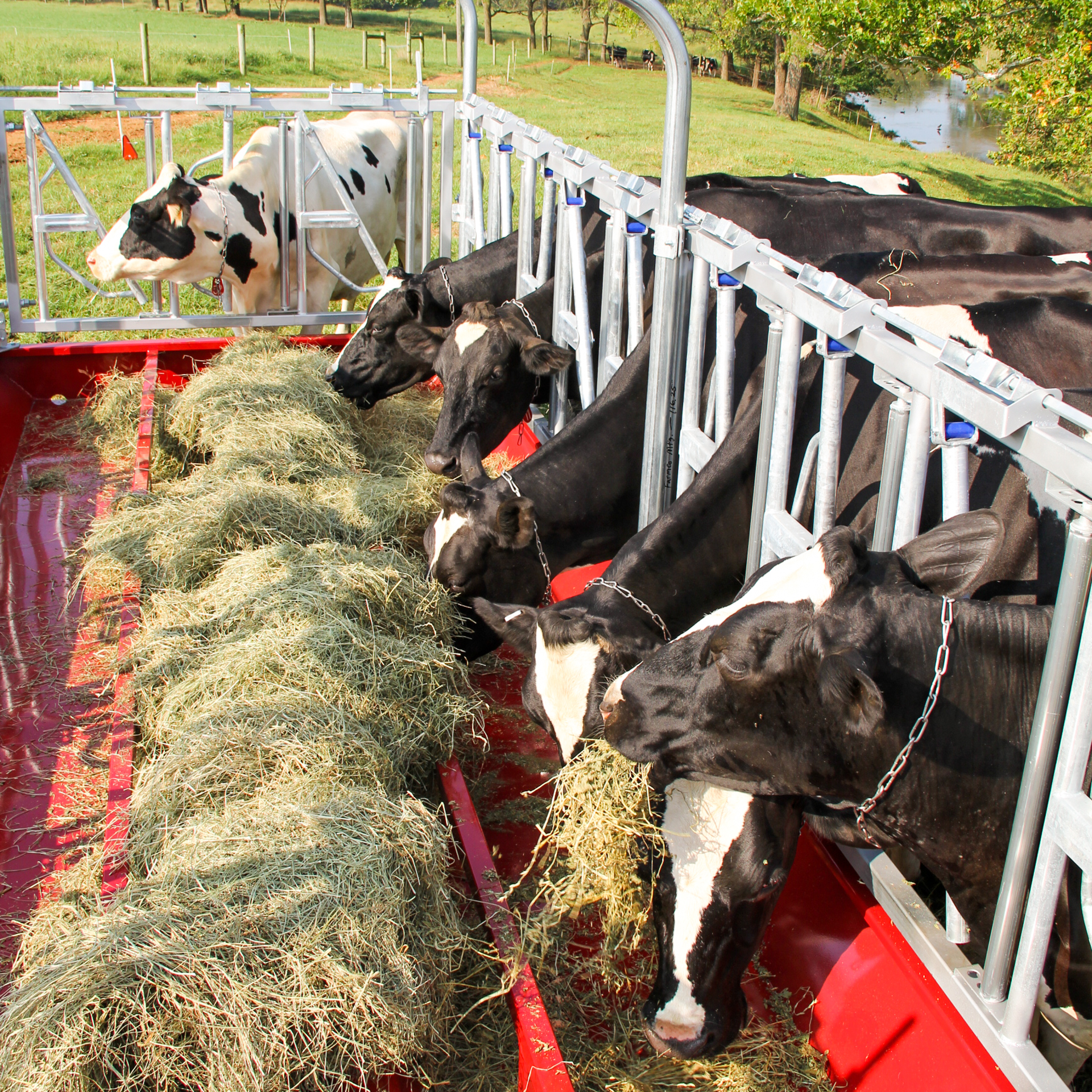
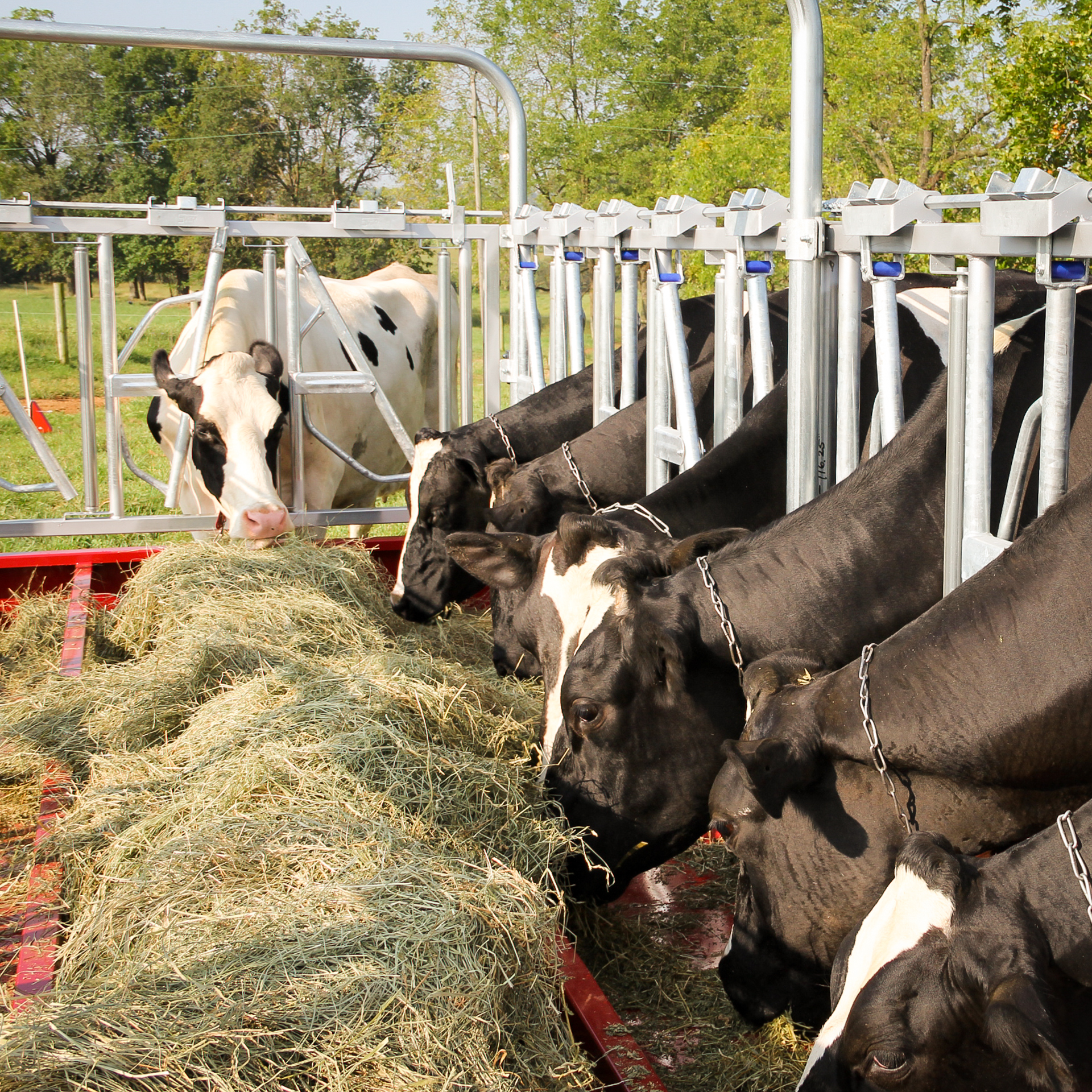
How To Keep Cows from Wasting Hay: Other Practical Methods
Here are several more practical methods to keep cows from wasting hay.
Feed in Well-Drained Areas
Cows will not eat hay that is infested with mud or manure. That’s why if you feed your cows on the ground, make sure that it is in an area that is well-drained, e.g. on gravel, concrete, or on tires. Avoiding low areas and marshy grass for feeding grounds is a good idea.
Feeding In Order
Storage plays a critical role in hay quality. Hay that is stored outside tends to be less high in quality and often has a greater percentage of wasted hay due to moisture and other weather conditions. It’s wise to first feed the lower quality (stored outside) hay first then give your cows the better hay last (hay stored inside).
Limit Supply of Hay
Don’t give unlimited access to hay for your cattle unless it’s in a raised hay slow feeder. Unlimited access to hay on the ground can waste incredible amounts of hay…up to 45%! If you figure a cow eats 25-30 lbs. of hay a day, that’s 340-400 lbs. of wasted hay per month per head! At a minimum, if you’re going to feed your cattle on the ground, at least limit the amount of hay to daily portions, which will at least cut back on some hay waste.
Ground Hay
Yes, grinding hay does help save on hay waste. It increases the palatability of the hay and also chops up the “stemmy” or “less desirable” pieces for the cattle. You can also purchase a hay processor that will chop the hay for you.
How Do You Feed Hay With No Waste to Cattle?
The short answer is that you can never have absolutely no waste when feeding hay to cattle. Even a cattle hay feeder does not completely eliminate hay waste. We’ve mentioned these ways before, but here are 2 ways you can reduce hay waste for cattle.
Hay Feeder
Probably the best long-term solution for cattle feeding is a minimum waste hay feeder for your cattle. Let’s look at 2 different examples of hay feeders that can greatly improve hay savings.
Bunk Feeder
About 4’ wide, 16” deep, and 8’-24’ long, you can pile plenty of nutrition at each feeding into a Farmco bunk feeder. With the option of slant bars welded around the perimeter of the bunk feeder, this option is an excellent-quality minimum hay waste feeder for cattle.
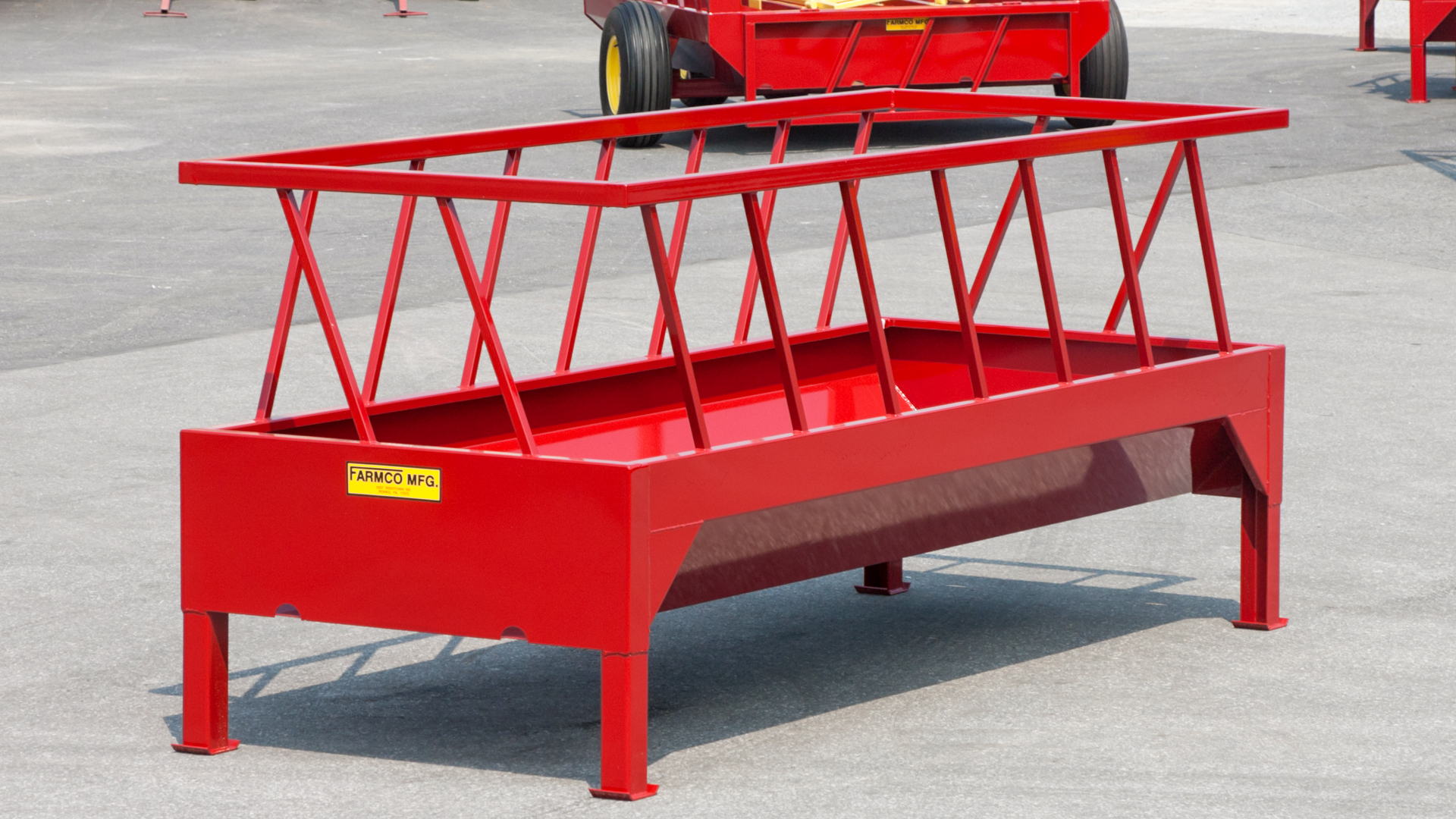
On top of that, a feed bunk from Farmco is built for rough, farm use. For example, our feed bunks are constructed using 12-gauge metal, with reinforcing at the points where it’s weakest.
Several more features of a Farmco feed bunk include:
- Slanted trough sides for reduced waste and simple cleaning
- 4 drain holes to get rid of moisture
- Reinforced, formed steel legs
- Slanted bars also promote slow feeding
700 DRB Large Bale Feeder
Hay feeders like the 700 DRB, are built to keep hay bales in the center of the feeder and encourage cattle to take smaller portions of hay. This all helps to keep your cattle from wasting hay.
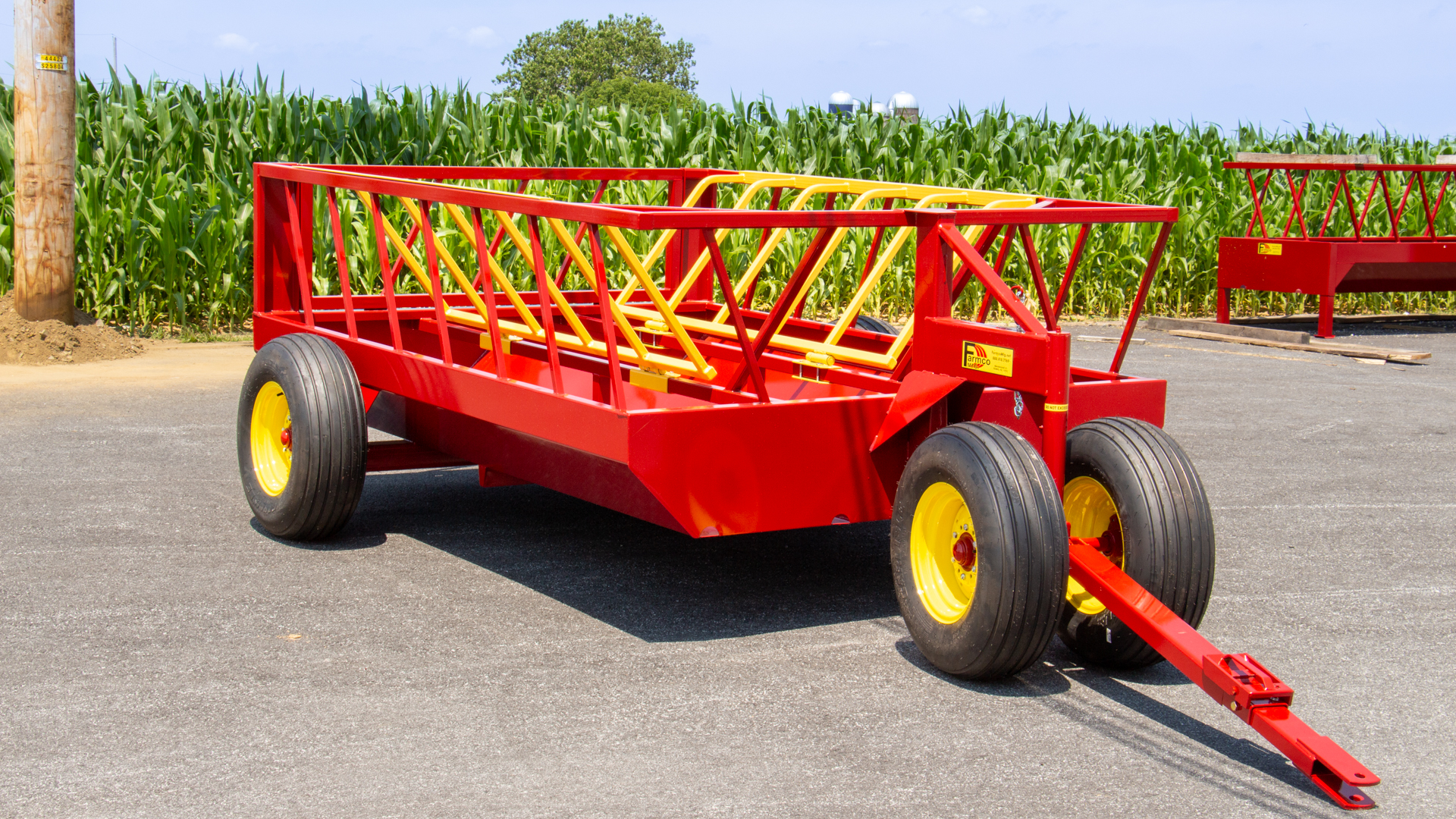
What’s more, is that the 700 DRB is extremely simple and easy to clean. Designed with EZ Clean-Out racks, which flip out of the way during cleaning. We’re not joking when we say that it takes less than 2 minutes to clean a 700 DRB Large Bale Feeder.
A couple more details about this feeder:
- “V” divider and slanted trough sides to keep hay in the center of the trough
- The feeder rests on (4) 15”x8” rims for easy transportation
- 180° turning front dolly for versatile maneuverability
- A metal tongue that can be stored away during feeding
- Back entry gate that flips down to make cleaning and loading hay simple and easy
- Tough, spring-loaded gate latch to keep your nosy cattle out of the feeder
While no company can truthfully sell a “no waste hay feeder for cattle,” our bunk feeder and 700 DRB feeders come pretty close to that “no waste hay feeder for cattle” motto!
Daily Feeding Methods
As we’ve mentioned above, feeding your cattle their daily amounts of hay rather than periodically dumping 2-3 days’ worth of hay in the pasture can really cut back on hay waste.
Hay Net
Hay nets can technically also be a periodic feeding method. We’ve also mentioned that hay nets are an affordable and efficient way to feed hay with minimal waste to cattle. However, the netting can be a hazard for your cow’s hoofs and can also be inefficient for large herds of cattle.
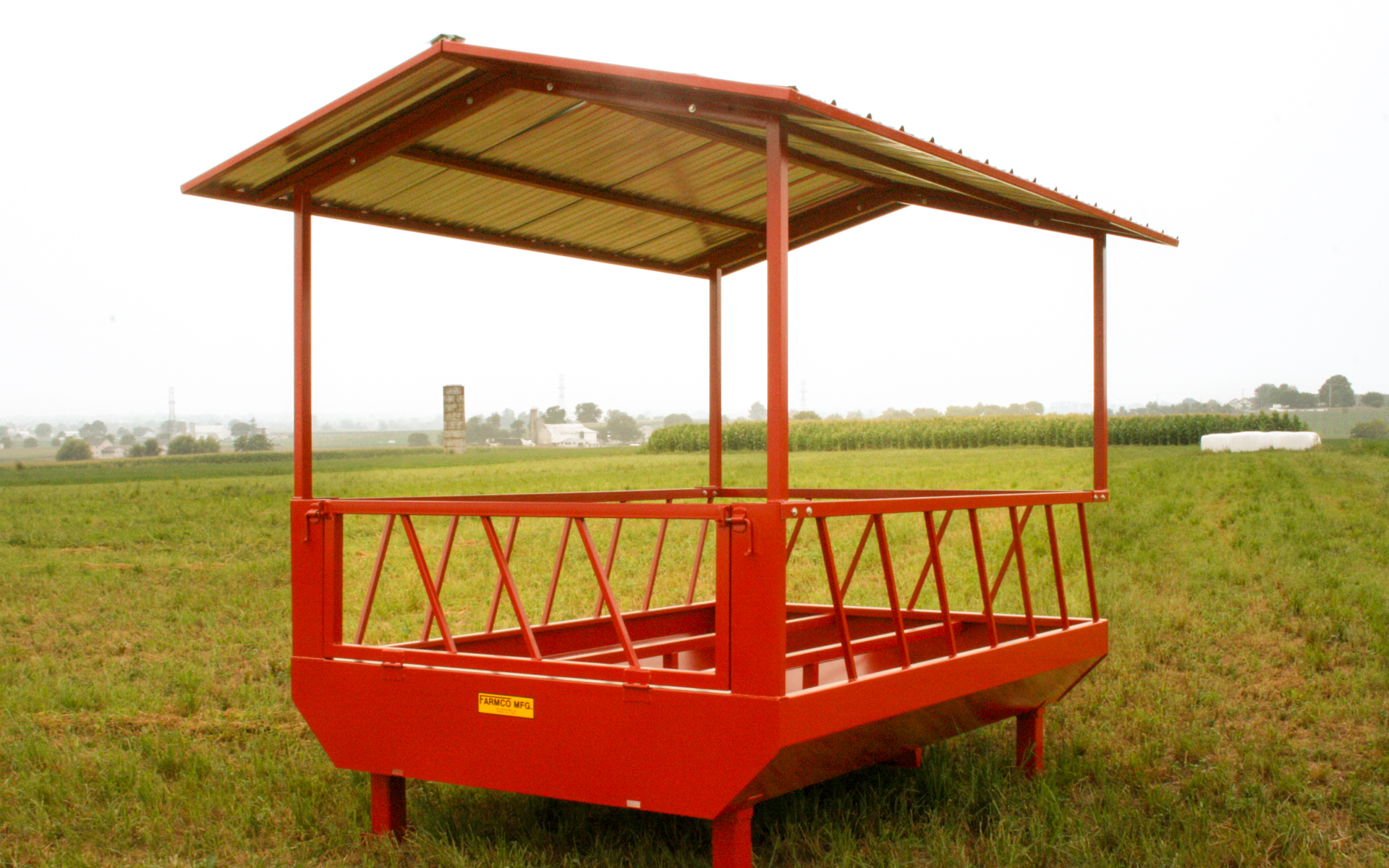
What is the Most Efficient Way to Feed Cows Hay?
The most efficient way to feed cows hay is by using a cattle hay feeder, such as a bunk feeder (we’ve got a whole article on the best way to feed hay to cattle). This keeps the hay off the ground, reduces feed trips, and keeps hay waste at a minimum. Essentially, a minimum waste hay feeder for cattle is the best, and most efficient, solution.
What Do We Call a Feeder that Helps Keep Hay Off the Ground?
A feeder that helps keep hay off the ground is called a hay feeder or raised cattle feeder. A cattle hay feeder is critical to keeping hay waste at a minimum and also helping your cows eat slower, while also saving you time cleaning the feeder and feeding your cows.
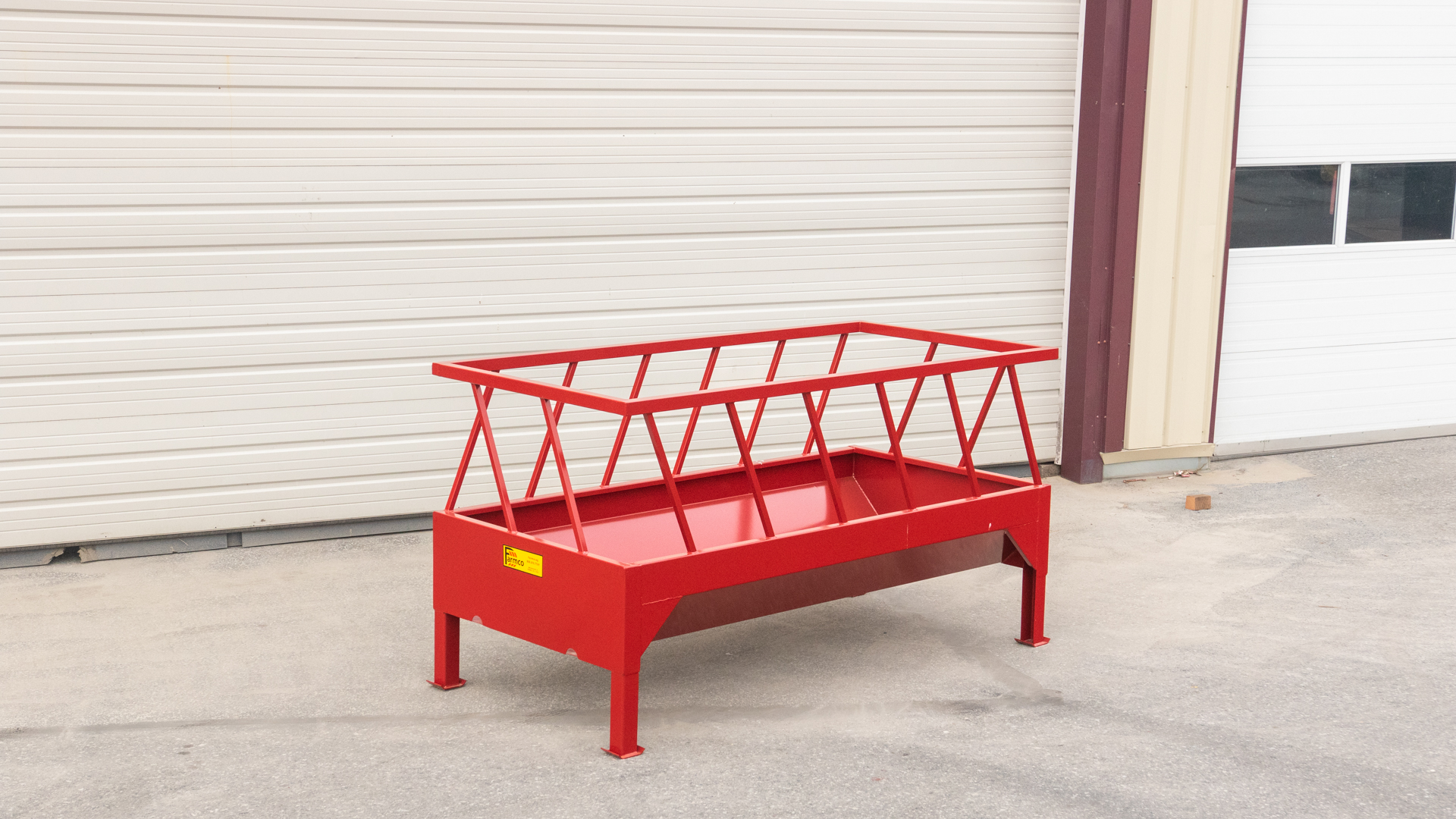
How Can I Make My Cow’s Hay Last Longer?
There are 3 main methods to help hay for your cattle last longer: invest in a hay feeder or hay net, change your feeding schedule to daily, and stop ground-feeding hay to your cattle.
Hay Feeder or Hay Net Investment
We’ve done plenty to explain why a hay feeder or hay net is a good investment above. Here’s a summary:
| Hay Feeder Pros | Hay Net Pros |
| Easy to clean | Easy to use |
| Spend less time feeding cattle | Drastically reduces hay waste |
| Drastically reduces hay waste | Affordable |
| Feeds a lot of cattle |
Change Feed Scheduling
If you ground-feed your cattle, only feed a day’s amount of hay (rather than several days) to your cows. This has been shown to drastically reduce hay waste in cattle feeding.
Stop Ground-Feeding Hay to Cattle
This may be one of the best keys to success. In order to get closer to the “no waste hay for cattle” motto, stop ground-feeding hay to your cattle and try investing in a hay feeder. You’ll see soon enough, the amount of money that you can save!
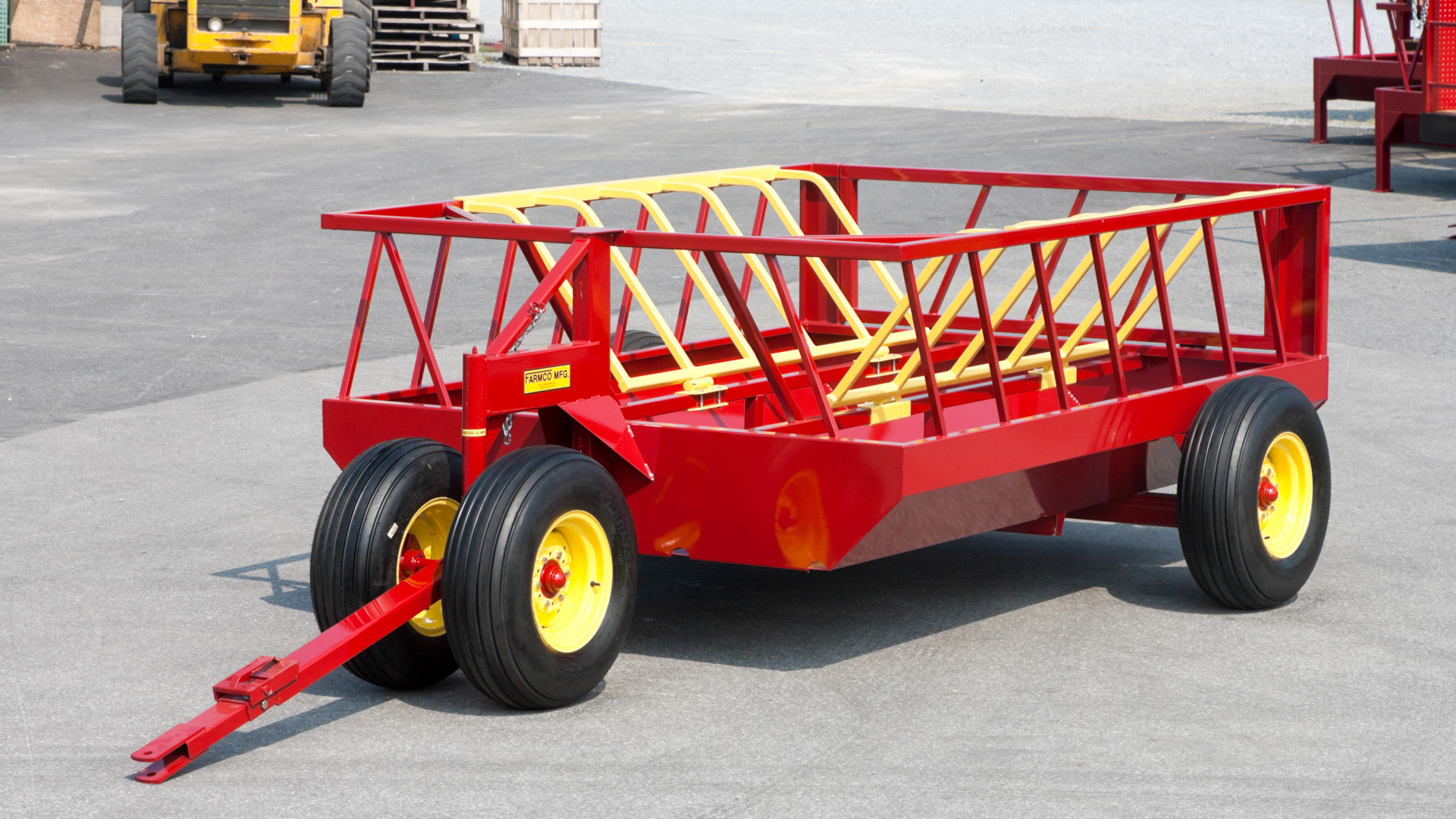
Wrapping it Up…
In summary, a minimum-waste cattle hay feeder is probably the best way to keep cows from wasting hay. Although feed scheduling changes can help in the short term, the best permanent solution is to invest now in a cattle hay feeder and save in the long term.
Since 1985, our team at Farmco Manufacturing has been dedicated to building exceptional farm equipment that is built to the following criteria:
- Unmatched Quality
- Creative
- Robust & Sturdy
- Farm-friendly
- Easy-to-use
- Built-to-last
We’d love to serve you in any way! If you’re interested in a quality cattle feeder, feel free to fill out a quick, free quote on any of our products (also read our article on small grain bin sizes)! Or, you can learn more about our cattle feeders below!





